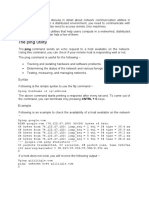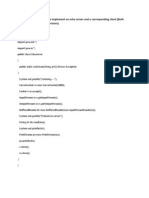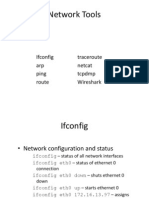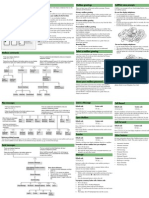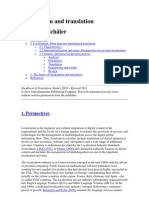PsPing v2.
1
29. 06. 2016. • 4 min za pročitati •
Sadržaj članka
Introduction
Installation
Using PsPing
Examples
By Mark Russinovich
Published: June 29, 2016
Download PsTools (2.7 MB)
Introduction
PsPing implements Ping functionality, TCP ping, latency and bandwidth
measurement. Use the following command-line options to show the usage for each
test type:
Installation
Copy PsPing onto your executable path. Typing "psping" displays its usage syntax.
Using PsPing
PsPing implements Ping functionality, TCP ping, latency and bandwidth
measurement. Use the following command-line options to show the usage for each
test type:
Usage:
cmd Kopiraj
psping -? [i|t|l|b\]
1
� Parameter Description
-? I Usage for ICMP ping.
-? T Usage for TCP ping.
-? L Usage for latency test.
-? B Usage for bandwidth test.
ICMP ping usage:
cmd Kopiraj
psping [[-6]|[-4]] [-h [buckets | <val1>,<val2>,...]] [-i <interval>] [-l
<requestsize>[k|m] [-q] [-t|-n <count>] [-w <count>] <destination>
Parameter Description
-h Print histogram (default bucket count is 20).
If you specify a single argument, it's interpreted as a bucket count and the
histogram will contain that number of buckets covering the entire time
range of values. Specify a comma-separated list of times to create a custom
histogram (e.g. "0.01,0.05,1,5,10").
-i Interval in seconds. Specify 0 for fast ping.
-l Request size. Append 'k' for kilobytes and 'm' for megabytes.
-n Number of pings or append 's' to specify seconds e.g. '10s'.
-q Don't output during pings.
-t Ping until stopped with Ctrl+C and type Ctrl+Break for statistics.
-w Warmup with the specified number of iterations (default is 1).
-4 Force using IPv4.
-6 Force using IPv6.
For high-speed ping tests use -q and -i 0.
2
�TCP ping usage:
cmd Kopiraj
psping [[-6]|[-4]] [-h [buckets | <val1>,<val2>,...]] [-i <interval>] [-l
<requestsize>[k|m] [-q] [-t|-n <count>] [-w <count>] <destination:dest-
port>
Parameter Description
-h Print histogram (default bucket count is 20).
If you specify a single argument, it's interpreted as a bucket count and the
histogram will contain that number of buckets covering the entire time
range of values. Specify a comma-separated list of times to create a custom
histogram (e.g. "0.01,0.05,1,5,10").
-i Interval in seconds. Specify 0 for fast ping.
-l Request size. Append 'k' for kilobytes and 'm' for megabytes.
-n Number of pings or append 's' to specify seconds e.g. '10s'.
-q Don't output during pings.
-t Ping until stopped with Ctrl+C and type Ctrl+Break for statistics.
-w Warmup with the specified number of iterations (default is 1).
-4 Force using IPv4.
-6 Force using IPv6.
For high-speed ping tests use -q and -i 0.
TCP and UDP latency usage:
server:
cmd Kopiraj
psping [[-6]|[-4]] [-f] <-s source:sourceport>
client:
3
� cmd Kopiraj
psping [[-6]|[-4]] [-f] [-u] [-h [buckets | <val1>,<val2>,...]] [-r] <-l
requestsize>[k|m]] <-n count> [-w <count>] <destination:destport>
Parameter Description
-f Open source firewall port during the run.
-u UDP (default is TCP).
-h Print histogram (default bucket count is 20).
If you specify a single argument, it's interpreted as a bucket count and the
histogram will contain that number of buckets covering the entire time
range of values. Specify a comma-separated list of times to create a custom
histogram (e.g. "0.01,0.05,1,5,10").
-l Request size. Append 'k' for kilobytes and 'm' for megabytes.
-n Number of sends/receives. Append 's' to specify seconds e.g. '10s'
-r Receive from the server instead of sending.
-w Warmup with the specified number of iterations (default is 5).
-4 Force using IPv4.
-6 Force using IPv6.
-s Server listening address and port.
The server can serve both latency and bandwidth tests and remains active until you
terminate it with Control-C.
TCP and UDP bandwidth usage:
server:
cmd Kopiraj
psping [[-6]|[-4]] [-f] <-s source:sourceport>
client:
4
� cmd Kopiraj
psping [[-6]|[-4]] [-f] [-u] [-h [buckets | <val1>,<val2>,...]] [-r] <-l
requestsize>[k|m]] <-n count> [-i <outstanding>] [-w <count>] <destina-
tion:destport>
Parameter Description
-f Open source firewall port during the run.
-u UDP (default is TCP).
-b Bandwidth test.
-h Print histogram (default bucket count is 20).
If you specify a single argument, it's interpreted as a bucket count and the
histogram will contain that number of buckets covering the entire time
range of values. Specify a comma-separated list of times to create a custom
histogram (e.g. "0.01,0.05,1,5,10").
-i Number of outstanding I/Os (default is min of 16 and 2x CPU cores).
-l Request size. Append 'k' for kilobytes and 'm' for megabytes.
-n Number of sends/receives. Append 's' to specify seconds e.g. '10s'
-r Receive from the server instead of sending.
-w Warmup for the specified iterations (default is 2x CPU cores).
-4 Force using IPv4.
-6 Force using IPv6.
-s Server listening address and port.
The server can serve both latency and bandwidth tests and remains active until you
terminate it with Control-C.
Examples
This command executes an ICMP ping test for 10 iterations with 3 warmup iterations:
5
� cmd Kopiraj
psping -n 10 -w 3 marklap
To execute a TCP connect test, specify the port number. The following command
executes connect attempts against the target as quickly as possible, only printing a
summary when finished with the 100 iterations and 1 warmup iteration:
cmd Kopiraj
psping -n 100 -i 0 -q marklap:80
To configure a server for latency and bandwidth tests, simply specify the -s option
and the source address and port the server will bind to:
cmd Kopiraj
psping -s 192.168.2.2:5000
A buffer size is required to perform a TCP latency test. This example measures the
round trip latency of sending an 8KB packet to the target server, printing a histogram
with 100 buckets when completed:
cmd Kopiraj
psping -l 8k -n 10000 -h 100 192.168.2.2:5000
This command tests bandwidth to a PsPing server listening at the target IP address
for 10 seconds and produces a histogram with 100 buckets. Note that the test must
run for at least one second after warmup for a histogram to generate. Simply add -u
to have PsPing perform a UDP bandwidth test.
cmd Kopiraj
psping -b -l 8k -n 10000 -h 100 192.168.2.2:5000
Download PsTools (2.7 MB)
6
�Je li vam stranica bila korisna?
Da Ne











